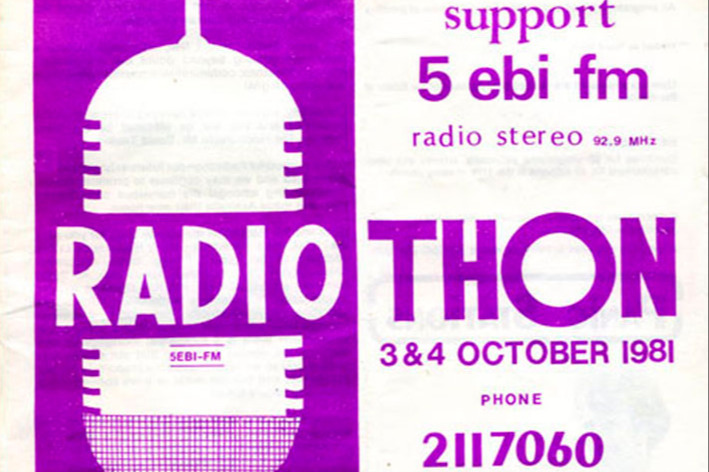1980s History 
1980
On the 6th January 1980, 5EBI made its FM debut on 102.3Mhz.
The station’s official launch was on February 2nd, with approximately 200,000 people expected to tune in. At the time the station was controlled by 33 committees, elected by ethnic and language groups in South Australia.
Two months after commencing transmission on 102.3 Mhz, 5EBI was extremely happy with its progress. The groups had many more live programs, compared to their time at 5UV, where the majority of programs were pre-recorded; and the station was receiving a “fantastic response” from their listeners.
In the words of 5EBI’s secretary at that time, George Kokoti, having more live programs created a real station atmosphere and helped to “bring the audience closer to us”. There were letters from people more than 90 km away. 5EBI was broadcasting more than 100 hours of programs each week.
The problem was that the station developed faster than expected; expanding at such a rate that its present premises couldn’t cope. New programs were starting constantly, placing more demands on studio time. More studio space was needed, and so plans to move to another building were inevitable.
From September 1980, 5EBI, having lost its battle with the Post and Telecommunications Department over frequency changes, thus being forced to shift to a new frequency on the FM dial, was to be heard on 92.9 Mhz.
Then a move from Mile End to 10 Byron Place, Adelaide (located between Gouger and Grote Streets), where a white brick antique salesroom was to be transformed into a modern radio station ... a very big event.
On the 1st of October the present building was purchased for $110,000 – EBI borrowed money to equip the place properly. At first it was very difficult to pay accounts, such as electricity, thus forcing EBI to pay them in installments, as well as prioritising their payments.
During this time of the planning development, many unofficial meetings and relevant discussions were held at the local Hungry Jack’s. But with lots of patience and good management, the building was eventually paid off.
1981
On 3rd October, 5EBI started broadcasting for the first time from their new Byron Place premises.
The call sign changed; the letters FM were added. The station could now broadcast in stereo with increased quality, especially for its music broadcasting. This was a tremendous boost for a radio station just beginning to flourish under its own steam.
The station ‘switched on’ with a two-day Radiothon, to raise funds for the three-studio building.
The station was off to a good start with a donation from the Government of South Australia. The new station converted from an old warehouse, encompassed reception offices, storage for records, library, meeting rooms, studios, record library, kitchen and bathrooms.
The ethnic communities made the move possible through devoted efforts and an unusual degree of co-operation. They could put aside individual politics and all differences, and put in the effort – donating their time and labour.
The station had been overwhelmed by the response from listeners to appeals for help in converting and renovating the warehouse. The support of the Adelaide City Council must also be commended for the way the building application process was handled, to enable an easy and quick conversion to a full scale radio station.
The new premises was opened by the Premier of South Australia, Mr. David Tonkin. The newspaper covering the opening event conveys the atmosphere as ‘truly cosmopolitan … with people wearing the national dress of their countries of origin, mingling with the multinational crowd of station workers and media representatives.’
Members of the 5EBI family were drawn from about 47 language communities, each with a radio committee, consisting of a President, Vice-President, Secretary, Treasurer and members. The committees’ many responsibilities included overseeing production, handling conflicts and paying fees to EBI.
Program contents varied greatly, subject to the presenter. Almost all of 5EBI’s programs were produced by volunteers. They dedicated their time to help preserve the language, culture and traditions of their home countries. But it’s not all hard work. They also have the opportunity to meet people from other ethnic backgrounds.
New volunteers were always welcome at 5EBI. The station and its communities benefited from getting more people involved. The presenters were able to touch the soul of their listeners through their programmes.
1984
The year 1984 marked a new beginning in Ethnic Broadcasting throughout Australia. The Public Broadcasting Association of Australia was seen as inadequate to promote and further ethnic community broadcasting. 4EB in Brisbane and 5EBI joined forces to help establish the National Ethnic Multicultural Broadcasting Council (NEMBC).
Luigi Penna, Vice Chairman of 5EBI at that time, was one of the first Vice Presidents. Hans Degenhart, Life Member of 5EBI, was an Executive member and Treasurer for many years. His wife Brenda Degenhart held the Chair of the Woman’s sub-committee for 2 years.
5EBI had also been involved in festivals and other multicultural events. Their special Outside Broadcast Van (OBV) was purchased and opened in 1985 by Chris Summer, Minister for Ethnic Affairs and Attorney General. It was subsequently used extensively to broadcast from events like the Schützenfest, Adelaide Royal Show, Glendi, and the Spanish Festival.
Many radio groups used the OBV to promote their events on-air and as a public address system at functions. Nowadays, of course, technology and logistics have marched on to the point where outside broadcasts no longer require a fully-equipped studio on wheels; so the OBV was eventually retired.

